Abstract
This article proposes a calibrated individual semantic (CIS)-based failure mode and effect analysis (FMEA) to deal with the risk evaluation of industrial internet platforms (IIP) from four perspectives: network security, data processing capability, equipment performance, and openness. The novelty of the CIS model is based on the deviation between linguistic terms and numerical values to calibrate linguistic scales of decision-makers (DMs). Not only can it handle situations in which different DMs have different understandings of the same term, but it is also suitable for multiple attributes decision-making with uncertainty. In addition, this new FMEA framework considers the consensus-reaching process as a way to eliminate the disagreement among DMs from different departments. Finally, a comparison between the proposed and traditional method is presented to illustrate the advantages of new method.
MSC:
20N25
1. Introduction
1.1. Background
The Industrial Internet has already attracted great interest from both industry and academia due to the explosive growth of novel technologies, such as big data, cloud computing, artificial intelligence, etc. []. In response to the “fourth industrial revolution”, General Electric (GE) first proposed the concept of the Industrial Internet in 2012, defining it as “the convergence of the global industrial system with the power of advanced computing, analytics, low-cost sensing and new levels of connectivity permitted by the Internet” [].
IIP, one of the most important core products of the Industrial Internet, is a service system that is based on the needs of digitalization, networking, and intelligence in manufacturing []. Though a large number of benefits have been brought to enterprises by IIPs, such as cost reductions, efficiency increases, improvements in products and services, innovations in business models, etc., there are still several problems in the construction and implementation of IIP, such as digital technology [], integration of systems [], cybersecurity [], openness of platform [], etc. However, few studies have focused on the overall risk management of the IIP. Therefore, in this paper we will introduce the framework of FMEA to reduce the problems and challenges posed by the implementation of IIP.
FMEA, originating from NASA in the 1960s, is a powerful risk management tool and engineering technique that can effectively manage the quality and reliability of products [,]. It has been widely used in identifying and eliminating potential failures, problems, errors from systems, designs, processes, and services []. Different from general risk evaluation methods that analyze problems after an adverse event occurs, FMEA is a tool for proactive risk assessment and management, evaluating and eliminating failures before they occur or reach customers [,]. Therefore, it has been widely utilized in various practical scenarios, such as cold-chain logistics management [], healthcare services [], energy issues [,], semiconductor manufacturing [], etc. Usually, a classic FMEA model includes the following four steps: (1) failure modes (FMs) and their causes and results are identified; (2) the risk priorities of FMs are determined by risk priority numbers (RPNs), which involves three risk factors: the probability of occurrence (O), the severity of effects (S), and the difficulty of detection (D); (3) the risk priority ranking of FMs is obtained, such that the FMs with larger RPN values would cause severer problems, requiring higher priorities; (4) corresponding measures are taken for high-risk issues [,,].
1.2. Related Work
FMEA has made a huge number of contributions in many fields, however, there are still some drawbacks for the traditional FMEA method.
On the one hand, DMs need to use crisp numbers to provide the risk factors number about FMs in the traditional FMEA approach []. However, it is difficult for DMs, as human beings and not machines, to describe risk levels of FMs precisely. To deal with uncertainty of evaluation in FMEA, a large number of approaches have been introduced, mainly including fuzzy set theory, evidence-based reasoning theory, developed methods based on 2-tuple linguistic model, etc. []. For example, a fuzzy FMEA was proposed that allows the RFs and their relative weights to be evaluated in a linguistic manner []; evidence-based reasoning theory was introduced into FMEA techniques to improve the effectiveness and flexibility of subjective information processing in uncertain environments [,,]. However, these approaches to deal with uncertainty are still far-removed from human expression habits, i.e., using linguistic labels or terms [].
On the other hand, computing with words (CW) was proposed by [] and the 2-tuple linguistic representation model was initiated by []. A large number of extended methods based on the 2-tuple linguistic model have been developed to a notable degree [,,]; probabilistic hesitant fuzzy language was presented to solve the problem of DMs hesitating between multiple options in the evaluation process []; linguistic distribution assessments can enable DMs to better reflect their actual experience and avoid information loss and distortion [,]; double hierarchy hesitant fuzzy linguistic term sets allow DMs to evaluate problems and solutions using a much more intuitive expression method [].
However, a problem still needs to be solved by these linguistic extended methods in that the same term has different meanings for different DMs. Thus, an optimization-based PIS model was designed to achieve linguistic calibration for different DMs []. Subsequently, more extended methods based on PIS have been reported. A consensus model for large-scale linguistic group decision-making (GDM) based on clustered PIS were created to improve the willingness of DMs who have to revise their preference []. To estimate the ignorance elements in incomplete distribution linguistic preference relations (DLPRs) and obtain the personalized numerical meanings of linguistic expressions to DMs, a consistency-driven methodology to manage DLPRs with PIS was proposed [].
However, a PIS model needs to assume that the preferences of individual DMs are as consistent as possible, which causes it to only accept pairwise comparisons of alternatives under one criterion. It is not friendly to DMs in the multi-attribute decision-making problem, because all the pairwise comparison matrices under different attributes must be provided by DMs. To solve this issue, we found an approach used to obtain personalized membership function. Ishizaka et al. [] proposed a method of calibrating the membership functions with comparisons given by DMs on alternatives with known measures. The best-matching scale of each DM is selected according to the mental representation of the verbal scale []. This article creates a novel individual semantic evaluation approach, called the CIS model, by combining membership function and verbal scale calibration to calibrate the linguistic terms provided by DMs.
1.3. Contribution
The primary work of this article can be summarized as follows. First, a designed linguistic calibration experiment is created to obtain the CISs to deal with the linguistic calibration and unify expression habits of DMs. Second, the possible inconsistencies of the FMEA team are solved by introducing the consensus reach process with minimum adjustment cost. Third, the developed method is applied into the risk management of IIP with 15 proposed FMs. Its main advantages are as follows:
- It proposes an experiment procedure based on the area of figures; essentially, it is a step of calibrating the psychological score of each DM for linguistic terms according to the membership function calibration proposed by Ishizaka et al. [,].
- The proposed CIS model is concise when it is applied to multi-attribute decision making. Compared with PIS model, a framework based on an optimization model is not necessary and it has a simpler converting process between linguistic terms and crisp value.
- This article uses the FMEA method to evaluation the risks of IIP. To the best of our knowledge, this is the first time of FMEA in an IIP risk evaluation. All data were obtained from questionnaires provided to staff of the company in this article.
The rest of this paper is organized as follows. In Section 2, a novel framework of FMEA is designed based on a CIS model considering a consensus-reaching process; the CIS model is proposed to convert linguistic terms into crisp values and is described in detail. Section 3 provides a real case of FMEA on IIP and applies it to the proposed model to analyze the FMs. In Section 4, the comparisons between the proposed and related FMEA methods are given to discuss its advantages. Finally, Section 5 concludes this article and points out future directions.
2. Materials and Methods
In this section, we will develop an extended linguistic FMEA method based on CIS considering the consensus-reaching process of multiple DMs, whose framework is shown in Figure 1. In detail, first, each DM needs to evaluate the FMs of IIP according to the given linguistic term set and provide an evaluation matrix. Second, every DM has to participate in a linguistic calibration experiment which is performed through the evaluation of measurable alternatives with the given linguistic term set. Third, a consensus-reaching process is introduced to ensure that all DMs achieve consensus. Finally, the rank of all FMs can be calculated by the collective evaluation matrix.
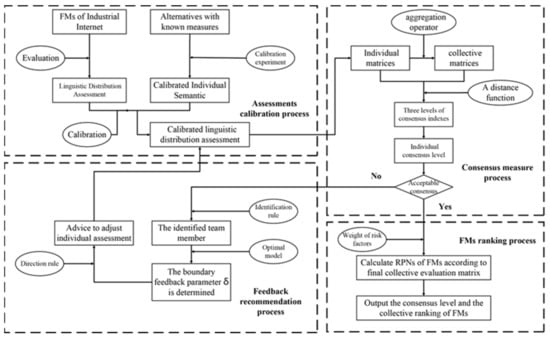
Figure 1.
The framework of proposed FMEA method.
The main innovation of the tdeveloped method is to propose a novel linguistic calibration approach, he CIS model. Compared with most existing linguistic methods, it considers the situation that different DMs have different understandings of the same term. It has a unique advantage in that it is based on the theoretical foundation of graphic area calibration experiments, avoiding the primary assumption that individuals’ preferences are as consistent as possible, in contrast to the PIS model. In addition, a process of group risk evaluations is involved in the FMEA method, where there usually exists disagreement among DMs. Thus, this article introduces a consensus-reaching process with a minimum adjustment cost feedback mechanism []; the consensus measure, inconsistency identification, and minimum adjustment cost feedback are described in [], but are not repeated.
When DMs express their evaluation about FMs, linguistic expressions are more in line with human habits than numerical expressions. However, the same words have different meanings for different individuals, which may lead to final error results. While PIS is a useful tool to deal with this problem, it assumes that the preferences of individual DMs are completely consistent, i.e., if alternative A is better than alternative B and if alternative B is better than alternative C, then alternative A cannot be worse than alternative C. In addition, the original preferences must be provided by pairwise comparison matrices in PIS model, which is not friendly to DMs in the multi-attribute decision-making problem, because all the pairwise comparison matrices under different attributes must be provided by DMs. Thus, this article proposes a novel individual semantic evaluation approach to calibrate the linguistic terms provided by DMs.
Inspired by the method of calibrating membership function [,], this article designs a CIS model to transform the linguistic terms provided by DMs into crisp numbers and includes two steps: (1) linguistic term collection based on the areas of graphics and (2) the calibration process of linguistic terms, as shown in Figure 2.
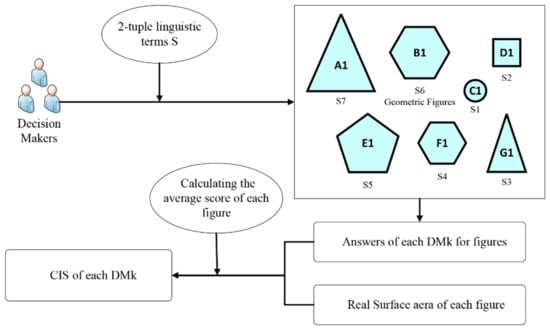
Figure 2.
The basic framework of CIS model.
Herrera and Martinez [] proposed the 2-tuple linguistic model in the framework of computing with words, which is a linguistic representation model widely used in different fields. Definition 1 illustrates:
Definition 1.
(The 2-tuple linguistic model). Let be a linguistic term set, and β ∈ [0,g] be a value representing the result of a symbolic aggregation operation. The 2-tuple linguistic model involves the transformation function between 2-tuples and numerical values as follows.
where function ∆ is a one-to-one mapping whose inverse function is equal to .
Based on Definition 1, each DM in FMEA team uses a 2-tuple linguistic model to evaluate the areas of u sets of graphics, there are g figures in each set, and their real areas are , respectively, where the area of xth figure in yth set is as provided by , where is a 2-tuple linguistic term. Please note that the area of each figure provided to DMs in each set of graphics is random, but in the u sets of graphics, there are g figures with area , which is beyond doubt. This guarantees that DMs will provide the area of the figures based on their judgment, rather than the ordering of graphics, so as to obtain the true psychological measurement error of DMs. The real areas of graphics and the mean value of the linguistic term provided by DMs are matched to calibrate the DMs’ linguistic term in the calibration process of linguistic terms. Thus, the CIS of about each linguistic term can be obtained as follows.
Here, . If it happens that , there exists wrong information provided by DMs or wrong information about figures, thus, DMs must update their evaluation or the information about figures is revised.
Example 1.
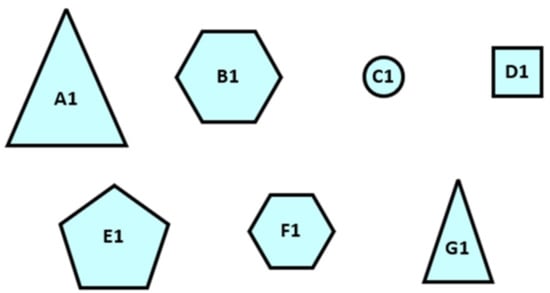
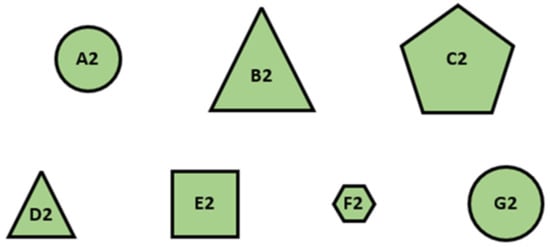
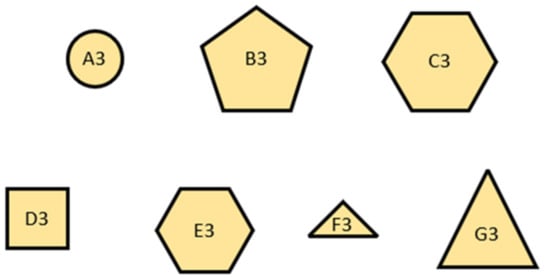
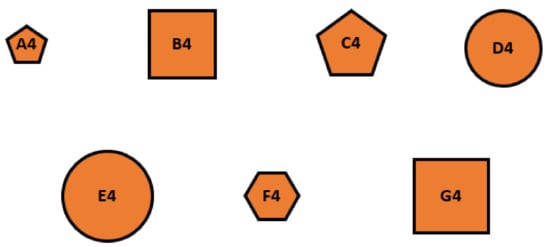
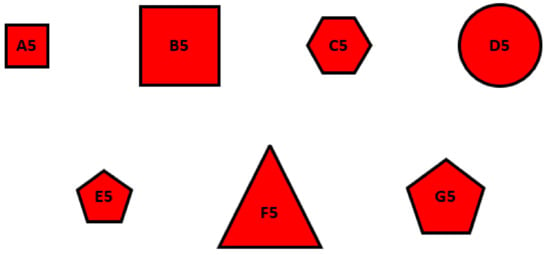





(Process of Calibrated Individual Semantic). A CIS numerical scales of different individual is required to convert the linguistic terms into crisp values. Suppose five DMs provide the areas of five sets of figures (there are 7 figures in each set) by the linguistic terms set, where the figures are depicted as Figure 3, Figure 4, Figure 5, Figure 6 and Figure 7 and the area of figures provided by DMs are shown as Table 1, Table 2, Table 3, Table 4 and Table 5.

Figure 3.
The first set of graphics.

Figure 4.
The second set of graphics.

Figure 5.
The third set of graphics.

Figure 6.
The fourth set of graphics.

Figure 7.
The fifth set of graphics.

Table 1.
Answers for calibration experiment of .

Table 2.
Answers for calibration experiment of .

Table 3.
Answers for calibration experiment of .

Table 4.
Answers for calibration experiment of .

Table 5.
Answers for calibration experiment of .
After processing, we get matrix as follows.
Thus, the CIS numerical scale and the semantic curves of CIS are obtained for different based on Equation (3), as shown in Table 6 and Figure 8.

Table 6.
The CIS numerical scales for different DMk.
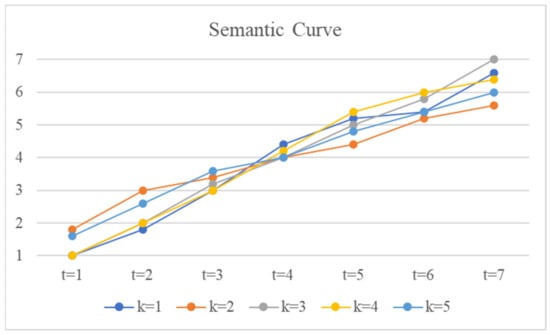
Figure 8.
The semantic curves of CIS.
After finishing the calibration process of the 2-tuple linguistic model, all the 2-tuple linguistic terms are transformed into numerical values. Here, we assume that a 2-tuple linguistic individual evaluation matrix about regarding three risk factors , including occurrence (O), severity (S), and detection (D), is , as provided by each in the FMEA team. Next, can be transformed into numerical individual evaluation matrix by the proposed CIS model. Then, the numerical collective evaluation matrix can be calculated as follows.
3. The Extended FMEA for Industrial Internet Platform
In this section, a case of IIP FMEA is provided, where five experts are invited to be the DMs to provided risk evaluations of fifteen FMs in Section 3 by 2-tuple linguistic terms for analysis of the potential failures of the IIP and improvement of its quality and reliability. Wherever the CIS model is used to revise the linguistic terms of DMs, a CRP with the minimum adjustment cost feedback mechanism is adopted to eliminate the disagreement among DMs, and a ranking process of FMs is achieved according to the final collective evaluation results.
3.1. Case Background
As mentioned in introduction, it is necessary to implement comprehensive risk management for IIP. However, there has been little investigation into the comprehensive risk management of IIP to date. Therefore, this article proposes fifteen FMs for IIP according to the literature from the four perspectives of network security , data processing capability , equipment performance , and openness , as shown in Table 7.

Table 7.
Failure Modes for Industrial Internet Platform.
3.2. Risk Information Collective and CIS Application
Five DMs are required to provide their risk evaluation matrices of regarding three , including Occurrence (O), Severity (S), and Detection (D), using linguistic terms set S = {= ‘extremely little’; = ‘very little’; = ‘little’; = ‘moderate’; = ‘large’; = ‘very large’; = ‘extremely large’}, as follows.
According to Table 5, the numerical risk evaluation matrix of is generated as follows.
3.3. Consensus Measure and Feedback Recommendation
The weights of the five DMs are assigned as based on their positions and work experience. Then, collective numerical risk evaluation matrix can be aggregated by individual numerical risk evaluation matrices , according to Equation (4), as follows.
Subsequently, the three levels of consensus indexes (CIs) of DMs are obtained [,,], as follows. The element-level CIs of DMs are:
CIs of DMs at FMs levels are:
The CIs of DMs are: . Based on the identification rules [,,,] and given consensus threshold , is inconsistent and the set of inconsistent elements is such that:
According to the minimum adjustment cost model [], the minimum adjustment cost feedback parameter for is solved as . Then, the adjusted numerical risk evaluation matrix of and updated collective numerical risk evaluation matrix can be obtained as follows:
After the feedback mechanism, the new CIs of DMs are calculated as . Since the CI of each DM in FMEA team has reached the consensus threshold, the final stage is activated to rank FMs.
3.4. Ranking of Failure Modes
According to the updated collective numerical risk evaluation matrix and the relative weight of risk factors , the RPN values of FMs are calculated by Equation (5), shown in Table 8, and the FMs are sorted in descending order according to the RPN value, like so: .

Table 8.
The CIS numerical scales for different .
Notice that this article assumes that the weights of RFs are assigned evenly, and the weights of DMs are given in advance based on position and experience of DMs; however, a full explanation of these techniques is beyond the scope of this paper. In the managerial practice of the proposed methodology, more interesting techniques can be introduced to extend the entire FMEA framework.
4. Comparison and Discussion
In order to demonstrate the advantages of the proposed method of FMEA for IIP, a comparison analysis is performed between the proposed method and the traditional FMEA without CIS in this subsection. The collective numerical risk evaluation matrix without CIS model, , is calculated; the CIs of DMs in FMEA team are exhibited in Figure 9. As can be seen in Figure 9, the CIs of DMs have improved by accepting CIS. Meanwhile, according to the threshold, has already achieved consensus after using CIS and no extra feedback recommendation process for is required.
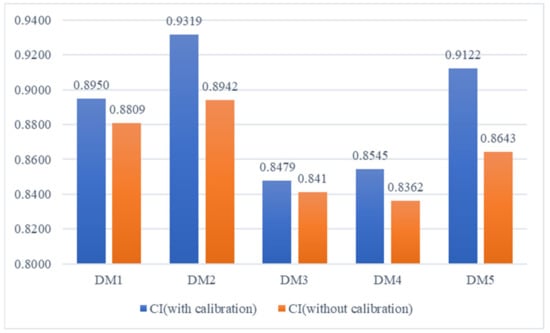
Figure 9.
The CI of DMs under different linguistic models.
Subsequently, the CRP with the minimum adjustment cost feedback mechanism is carried out without CIS. Boundary feedback parameters are , respectively, and the updated collective numerical risk evaluation matrix without CIS model is calculated as:
Then, the RPNs of FMs is calculated according to , shown in Table 9 and the ranking of FMs is .

Table 9.
The CIS numerical scales for different DMk.
Based on the above comparison analysis, it is obvious that linguistic expressions of DMs are a key issue affecting the final result of group decision-making by affecting the CIs among DMs, in addition to knowledge background, work experience, and so on, which means that an additional adjustment cost will be paid for the individual differences in linguistic terms.
Additionally, the technique of linguistic calibration will affect the final rank of FMs by comparing the final ranking results of FMs, whose differences can be attributed to the implementation of linguistic calibration. There exists a similar result between the proposed and traditional method in the ranking of FMs with the highest and least risk, which demonstrates that the proposed method is effective.
In order to illustrate the distinctions of the proposed mechanism, a theoretical comparison with existing FMEA methods is presented from four perspectives: ‘what expression preference is used?’, ‘what linguistic calibration mechanism is adopted?’, ‘is a consensus process involved?’ and ‘to what practice is it applied?’, as shown in Table 10. In terms of expression preference, different linguistic expressions have their unique advantages. While the more complex the linguistic method is, the less loss of information there will be, the difficulty of application will also increase significantly. Therefore, 2-tuple linguistic methods are more popular with the public than other approaches due to their practicality. As for linguistic calibration, it is very important to address the fact that different DMs have different understandings of the same term. Compared with the PIS model, there exists no assumption that each preference is as consistent as possible in the CIS model, and so it is much easier to tackle the multi-attribute multi-alternative decision-making problem. Compared to [,,], it is crucial to achieve consensus for a group of DMs in order to better implement the result of FMEA, because the DMs of an FMEA team often come from different fields and organizations with various professional skills, education backgrounds, and work experiences. In practice, the FMEA method proposed by Huang et.al. [] was applied to the risk evaluation of a grinding wheel system, while Duan et.al. [] proposed a FMEA model with double hierarchy hesitant fuzzy linguistic term sets and k-means clustering for the risk evaluation of floating offshore wind turbines. FMEA based on possibilistic hesitant fuzzy linguistic information with consensus process has been applied in the risk evaluation of proton beam radiotherapy [], and a large-scale FMEA model with social network analysis and fairness-oriented consensus process has been utilized for photovoltaic systems []. In addition, a PIS-based FMEA approach with incomplete preference was adopted to the reliability management of blood transfusion [].

Table 10.
Comparisons with related FMEA methods.
5. Conclusions and Future Work
This article proposes a novel FMEA framework based on a CIS model considering a consensus-reaching process. Its main contributions are as follows:
An improved FMEA approach must address issues such as effectiveness, difficulty, practicality, etc. The proposed method does so as follows. First, compared with the conventional FMEA method, the proposed method has improved ability to tackle information uncertainties compared to the crisp values of RFs given by the 2-tuple linguistic model. Second, in contrast to the existing linguistic calibration method, not only is the figure-based CIS model more convenient to operate than the PIS model, but it also has a stronger reference foundation, making it more suitable for practical scenarios. Third, the proposed FMEA framework can better solve the disagreement between different DMs via a consensus-reaching process with a minimum adjustment cost feedback mechanism, as DMs in FMEA evaluation teams are usually from different organizations and departments. Fourth, the use of a real case of IIP illustrates the proposed FMEA framework, where the data involved are sourced from the staff of an industrial internet company.
In the future, the frameworks of large-scale group decision-making models will be introduced into FMEA problems to extend application scenarios, because there are usually a large number of FMEA evaluation members from multiple departments who are involved in complex decision-making. However, the relative weights of DMs are not considered in this article, being beyond the scope of the present research focus. Thus, in future work, the weights of DMs will be assigned based on the deviation between individual CIS curves and original curves. Furthermore, as the possible interrelationships between risk factors can affect the outcomes of risk rankings, such interrelationships will also be considered in the adjustment of risk factor weights in future work.
Author Contributions
Conceptualization, J.C. and W.L.; methodology, J.C. and M.C.; software, J.C.; validation, J.C., W.L. and M.C.; formal analysis, J.C. and J.W.; investigation, J.C. and Y.L.; resources, J.C.; data curation, J.C.; writing—original draft preparation, J.C.; writing—review and editing, W.L. and J.W.; visualization, W.L. and Y.L.; supervision, J.W. and C.L.; project administration, J.W. and C.L.; funding acquisition, J.W. All authors have read and agreed to the published version of the manuscript.
Funding
This research was funded by National Natural Science Foundation of China (NSFC). (No. 71971135,72131006,72001134), China Scholarship Council (No. 202108310183) and Innovative Talent Training Project of Graduate Students in Shanghai Maritime University of China (2021YBR006).
Institutional Review Board Statement
Not applicable.
Informed Consent Statement
Not applicable.
Data Availability Statement
Data is contained within the article.
Conflicts of Interest
The authors declare no conflict of interest.
References
- Li, J.-Q.; Yu, F.R.; Deng, G.; Luo, C.; Ming, Z.; Yan, Q. Industrial Internet: A Survey on the Enabling Technologies, Applications, and Challenges. IEEE Commun. Surv. Tutor. 2017, 19, 1504–1526. [Google Scholar] [CrossRef]
- Cheng, J.; Zhang, H.; Tao, F.; Juang, C.-F. DT-II:Digital twin enhanced Industrial Internet reference framework towards smart manufacturing. Robot. Comput. Manuf. 2019, 62, 101881. [Google Scholar] [CrossRef]
- Wang, J.L.; Xu, C.Q.; Zhang, J.; Bao, J.S.; Zhong, R. A collaborative architecture of the industrial internet platform for manufac-turing systems. Robot. Comput. -Integr. Manuf. 2020, 61, 101854. [Google Scholar] [CrossRef]
- Falco, G.; Caldera, C.; Shrobe, H. IIoT Cybersecurity Risk Modeling for SCADA Systems. IEEE Internet Things J. 2018, 5, 4486–4495. [Google Scholar] [CrossRef]
- Menon, K.; Kärkkäinen, H.; Wuest, T.; Gupta, J.P. Industrial internet platforms: A conceptual evaluation from a product lifecycle management perspective. Proc. Inst. Mech. Eng. Part B J. Eng. Manuf. 2018, 233, 1390–1401. [Google Scholar] [CrossRef]
- Baykasoğlu, A.; Gölcük, I. Comprehensive fuzzy FMEA model: A case study of ERP implementation risks. Oper. Res. 2017, 20, 795–826. [Google Scholar] [CrossRef]
- Liu, H.-C.; Wang, L.-E.; Li, Z.; Hu, Y.-P. Improving Risk Evaluation in FMEA With Cloud Model and Hierarchical TOPSIS Method. IEEE Trans. Fuzzy Syst. 2018, 27, 84–95. [Google Scholar] [CrossRef]
- Kutlu, A.C.; Ekmekçioğlu, M. Fuzzy failure modes and effects analysis by using fuzzy TOPSIS-based fuzzy AHP. Expert Syst. Appl. 2012, 39, 61–67. [Google Scholar] [CrossRef]
- Huang, J.; Li, Z.; Liu, H.-C. New approach for failure mode and effect analysis using linguistic distribution assessments and TODIM method. Reliab. Eng. Syst. Saf. 2017, 167, 302–309. [Google Scholar] [CrossRef]
- Liu, H.-C.; Hu, Y.-P.; Wang, J.-J.; Sun, M. Failure Mode and Effects Analysis Using Two-Dimensional Uncertain Linguistic Variables and Alternative Queuing Method. IEEE Trans. Reliab. 2018, 68, 554–565. [Google Scholar] [CrossRef]
- Wu, J.-Y.; Hsiao, H.-I. Food quality and safety risk diagnosis in the food cold chain through failure mode and effect analysis. Food Control 2020, 120, 107501. [Google Scholar] [CrossRef]
- Faiella, G.; Parand, A.; Franklin, B.D.; Chana, P.; Cesarelli, M.; Stanton, N.; Sevdalis, N. Expanding healthcare failure mode and effect analysis: A composite proactive risk analysis approach. Reliab. Eng. Syst. Saf. 2018, 169, 117–126. [Google Scholar] [CrossRef] [Green Version]
- Duan, C.-Y.; Chen, X.-Q.; Shi, H.; Liu, H.-C. A New Model for Failure Mode and Effects Analysis Based on k-Means Clustering Within Hesitant Linguistic Environment. IEEE Trans. Eng. Manag. 2019, 69, 1837–1847. [Google Scholar] [CrossRef]
- Karatop, B.; Taşkan, B.; Adar, E.; Kubat, C. Decision analysis related to the renewable energy investments in Turkey based on a Fuzzy AHP-EDAS-Fuzzy FMEA approach. Comput. Ind. Eng. 2020, 151, 106958. [Google Scholar] [CrossRef]
- Jee, T.L.; Tay, K.M.; Lim, C.P. A New Two-Stage Fuzzy Inference System-Based Approach to Prioritize Failures in Failure Mode and Effect Analysis. IEEE Trans. Reliab. 2015, 64, 869–877. [Google Scholar] [CrossRef]
- Huang, J.; You, J.-X.; Liu, H.-C.; Song, M.-S. Failure mode and effect analysis improvement: A systematic literature review and future research agenda. Reliab. Eng. Syst. Saf. 2020, 199, 106885. [Google Scholar] [CrossRef]
- Liu, H.-C.; You, J.-X.; You, X.-Y.; Shan, M.-M. A novel approach for failure mode and effects analysis using combination weighting and fuzzy VIKOR method. Appl. Soft Comput. 2015, 28, 579–588. [Google Scholar] [CrossRef]
- Liu, H.-C.; Chen, X.Q.; Duan, C.Y.; Wang, Y.M. Failure mode and effect analysis using multi-criteria decision making meth-ods: A systematic literature review. Comput. Ind. Eng. 2019, 135, 881–897. [Google Scholar] [CrossRef]
- Hadi-Vencheh, A.; Hejazi, S.; Eslaminasab, Z. A fuzzy linear programming model for risk evaluation in failure mode and effects analysis. Neural Comput. Appl. 2012, 22, 1105–1113. [Google Scholar] [CrossRef]
- Qin, J.; Xi, Y.; Pedrycz, W. Failure mode and effects analysis (FMEA) for risk assessment based on interval type-2 fuzzy evidential reasoning method. Appl. Soft Comput. 2020, 89, 106134. [Google Scholar] [CrossRef]
- Wu, D.; Tang, Y. An improved failure mode and effects analysis method based on uncertainty measure in the evidence theory. Qual. Reliab. Eng. Int. 2020, 36, 1786–1807. [Google Scholar] [CrossRef]
- Zhou, D.; Tang, Y.; Jiang, W. A Modified Model of Failure Mode and Effects Analysis Based on Generalized Evidence Theory. Math. Probl. Eng. 2016, 2016, 1–11. [Google Scholar] [CrossRef] [Green Version]
- La, Z. Fuzzy logic equals Computing with words. IEEE Trans. Fuzzy Syst. 1996, 4, 103–111. [Google Scholar]
- Martinez, L.; Herrera, F. A 2-tuple fuzzy linguistic representation model for computing with words. IEEE Trans. Fuzzy Syst. 2000, 8, 746–752. [Google Scholar] [CrossRef] [Green Version]
- Nie, R.X.; Tian, Z.P.; Wang, X.K.; Wang, J.Q.; Wang, T.L. Risk evaluation by FMEA of supercritical water gasification system using multi-granular linguistic distribution assessment. Knowl. Based Syst. 2018, 162, 185–201. [Google Scholar] [CrossRef]
- Zhang, G.Q.; Dong, Y.C.; Xu, Y.F. Consistency and consensus measures for linguistic preference relations based on distribu-tion assessments. Inf. Fusion 2014, 17, 46–55. [Google Scholar] [CrossRef]
- Huang, J.; You, X.-Y.; Liu, H.-C.; Si, S.-L. New approach for quality function deployment based on proportional hesitant fuzzy linguistic term sets and prospect theory. Int. J. Prod. Res. 2018, 57, 1283–1299. [Google Scholar] [CrossRef]
- Li, C.-C.; Dong, Y.; Herrera, F.; Herrera-Viedma, E.; Martínez, L. Personalized individual semantics in computing with words for supporting linguistic group decision making. An application on consensus reaching. Inf. Fusion 2017, 33, 29–40. [Google Scholar] [CrossRef] [Green Version]
- Li, C.-C.; Dong, Y.; Herrera, F. A Consensus Model for Large-Scale Linguistic Group Decision Making With a Feedback Recommendation Based on Clustered Personalized Individual Semantics and Opposing Consensus Groups. IEEE Trans. Fuzzy Syst. 2018, 27, 221–233. [Google Scholar] [CrossRef]
- Li, C.C.; Gao, Y.; Dong, Y.C. Managing Ignorance Elements and Personalized Individual Semantics Under Incomplete Lin-guistic Distribution Context in Group Decision Making. Group Decis. Negot. 2021, 30, 97–118. [Google Scholar] [CrossRef]
- Ishizaka, A.; Nam, H.N. Calibrated fuzzy AHP for current bank account selection. Expert Syst. Appl. 2013, 40, 3775–3783. [Google Scholar] [CrossRef] [Green Version]
- Meesariganda, B.R.; Ishizaka, A. Mapping verbal AHP scale to numerical scale for cloud computing strategy selection. Appl. Soft Comput. 2017, 53, 111–118. [Google Scholar] [CrossRef] [Green Version]
- Wu, J.; Dai, L.F.; Chiclana, F.; Fujita, H.; Herrera-Viedma, E. A minimum adjustment cost feedback mechanism based con-sensus model for group decision making under social network with distributed linguistic trust. Inf. Fusion 2018, 41, 232–242. [Google Scholar] [CrossRef]
- Cao, M.; Liu, Y.; Gai, T.; Zhou, M.; Fujita, H.; Wu, J. A Comprehensive Star Rating Approach for Cruise Ships Based on Interactive Group Decision Making with Personalized Individual Semantics. J. Mar. Sci. Eng. 2022, 10, 638. [Google Scholar] [CrossRef]
- Wu, J.; Cao, M.S.; Chiclana, F.; Dong, Y.C.; Herrera-Viedma, E. An optimal feedback model to prevent manipulation behav-ior in consensus under social network group decision making. IEEE Trans. Fuzzy Syst. 2021, 29, 1750–1763. [Google Scholar] [CrossRef] [Green Version]
- Liu, Y.; Zhang, H.; Wu, Y.; Dong, Y. Ranking range based approach to MADM under incomplete context and its application in venture investment evaluation. Technol. Econ. Dev. Econ. 2019, 25, 877–899. [Google Scholar] [CrossRef]
- Wu, J.; Hong, Q.; Cao, M.; Liu, Y.; Fujita, H. A group consensus-based travel destination evaluation method with online reviews. Appl. Intell. 2021, 52, 1306–1324. [Google Scholar] [CrossRef]
- Xing, Y.M.; Cao, M.S.; Liu, Y.J.; Zhou, M.; Wu, J. A Choquet integral based interval Type-2 trapezoidal fuzzy multiple at-tribute group decision making for Sustainable Supplier Selection. Comput. Ind. Eng. 2022, 165, 107935. [Google Scholar] [CrossRef]
- Zhang, H.; Dong, Y.; Palomares-Carrascosa, I.; Zhou, H. Failure Mode and Effect Analysis in a Linguistic Context: A Consensus-Based Multiattribute Group Decision-Making Approach. IEEE Trans. Reliab. 2018, 68, 566–582. [Google Scholar] [CrossRef] [Green Version]
- Zhang, Y.; Zhang, P.; Tao, F.; Liu, Y.; Zuo, Y. Consensus aware manufacturing service collaboration optimization under blockchain based Industrial Internet platform. Comput. Ind. Eng. 2019, 135, 1025–1035. [Google Scholar] [CrossRef]
- Tang, M.; Liao, H. Failure mode and effect analysis considering the fairness-oriented consensus of a large group with core-periphery structure. Reliab. Eng. Syst. Saf. 2021, 215, 107821. [Google Scholar] [CrossRef]
Publisher’s Note: MDPI stays neutral with regard to jurisdictional claims in published maps and institutional affiliations. |
© 2022 by the authors. Licensee MDPI, Basel, Switzerland. This article is an open access article distributed under the terms and conditions of the Creative Commons Attribution (CC BY) license (https://creativecommons.org/licenses/by/4.0/).